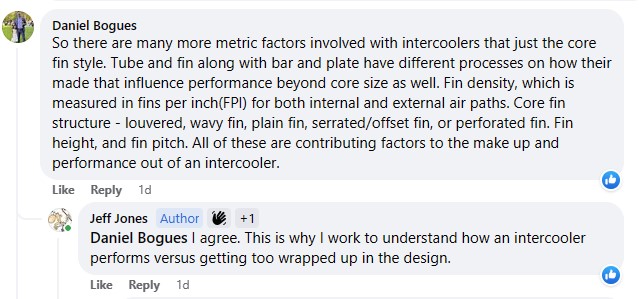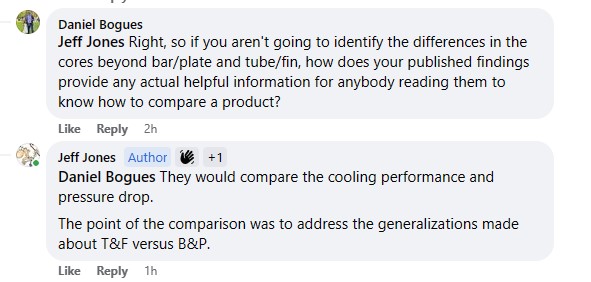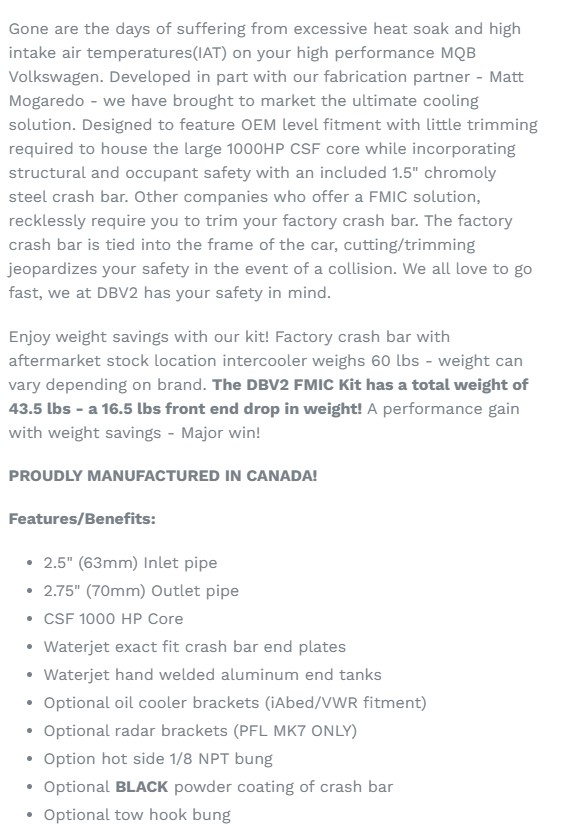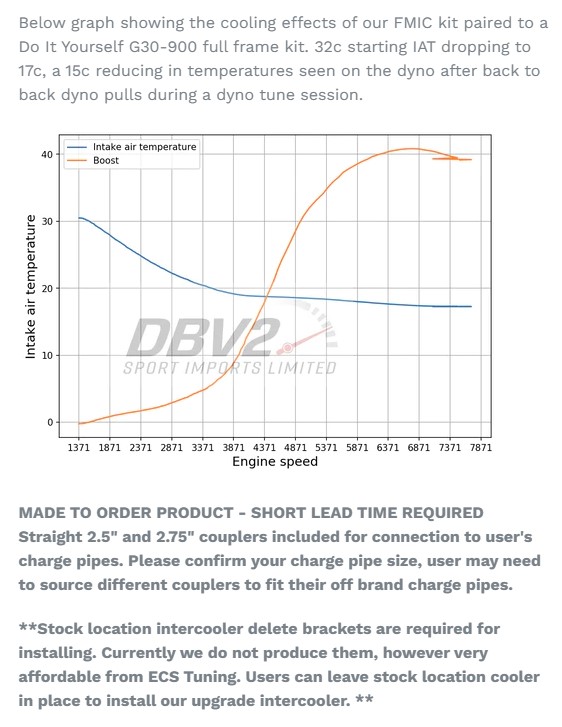Background:
Daniel Bogues, a member at DBV2 Sport Imports Limited, brought up some concerns about the information presented in a post I made where I compared a Tube & Fin style intercooler with a Bar & Plate style.
Each intercooler was from a supplier of aftermarket parts that appear to be reputable, Racingline and do88, and the intent of the post was to illustrate that generalizing that one type of intercooler core design outperforms the other in terms of temperature recovery might not be correct.

Because the posts on this site are an opinion, and the viewpoint of a consumer, I believe it’s worthwhile to review some of the concerns raised about the content on this site.
This is especially relevant when the feedback is from vendors who provide consumers with their own information about the same aftermarket products and services.
The gist of the concern is:
If I’m not going to identify design-specific differences between IC models, such as fins per inch of the internal and external passages, core fin structure, fin height, and fin pitch, then how do the IC test results I publish provide helpful information for comparing intercoolers?
Analysis:
Addressing the concerns brought up by Daniel are:

Recognizing that there are multiple factors that affect an IC performance is not a point of disagreement, in the original post I briefly touched on this subject:
Often the claim will be accompanied by a description of the physical attributes of each IC type, with a leap of logic to the conclusion that one type of intercooler performs better than the other.
Tube and Fin vs Bar and Plate Temperature Recovery Post
To expand on this subject the diagram below will be referenced.
As Daniel pointed out there are a number of factors that come into play in determining the performance of an intercooler.
The factors that Daniel mentioned, fins per inch, fins structure, etc. are the Input Factors (IF). In the diagram, I have listed a dozen input factors, although there are likely more. The black arrows are pointed at the Intercooler block to indicate that they are contributing to an output from the Intercooler.
The intercooler’s “performance” is the output. The red arrows pointing away from the Intercooler show output, these are the Response Variables (RV). Two that I believe are important to measure are the IC outlet air temperature and pressure drop across the intercooler.

The charge air temperature that is an output (RV1) from the Intercooler becomes an input factor to the engine. The pressure drop is an input factor to the turbocharger, the more pressure drop the IC presents to the turbocharger the greater pressure it must generate to meet the engine demands. If the turbocharger needs to produce greater pressure then this in turn raises exhaust gas backpressure (RV3), affecting the engine power output, thus, this exhaust gas backpressure (RV3) is an input factor to the engine.
The testing I conduct on intercoolers measures the two IC response variables (RV); Charge Air Temperature and Pressure Drop. This is because they are input factors to the engine which has Power and Torque as response variables (RV4).

The response I provided to Daniel sums up my opinion of how important it is for consumers to have an in-depth understanding of how the IC input (design) factors (IF) contribute to the response variables (RV) (cooling & pressure drop).
From a practical standpoint determining the internal fin structure, fins per inch, fin height, etc. would be quite difficult since it would require access to the inside of the core. I have cataloged some dimensions of the intercoolers I have had access to, or whose manufacturers provide information, but haven’t found this information useful for predicting the cooling efficiency of the intercoolers.
Daniel states “BMW market, consumers are well informed and are measuring different cores of vendors offerings.”
To accomplish what Daniel states is occurring in the BMW Market would require understanding the contributions of each of the 12+ input factors to the Response Variables. Each factor has several levels, the possible values for the factor. For example, external fins per inch on GTI intercoolers range from around 8 to 22, so determining the relationship between the fins per inch and output temperature would require measuring multiple fin densities while holding other factors constant. This would then be repeated for each of the input factors.
Even if each input factor only had two levels, for example, fins per inch are only 8 or 22, it would take over 4,000 experimental runs to understand the main effects and interactions. If the consumers in the BMW Market are not evaluating all of the variables, for instance, if they only measure the external size of the core, the external fins per inch, and the number of charge air rows, there’s no way of knowing if a significant factor is being unaccounted for, making the conclusions unreliable.
Notably, Daniel from DBV2 states that only Unitronic advertises its core fin structure, but it appears that at least APR also does. It’s also worth noting that although DBV2 believes this information is critical for consumers to be well informed, DBV2 fails to provide this critical information about its True Front Mount intercooler.

What Daniel believes is important to provide to consumers would take far more work (4,000+ experimental runs) than I am willing to devote to getting that information.
Since Daniel heavily disagrees with my viewpoint on what is important to an end user, here’s a Holiday theme analogy to illustrate our differing opinions.

I’m making Christmas Cookies ahead of guests arriving at my house.
There are a number of input factors that go into making a good-tasting cookie (Response Variable – RV), just like there are a number of input factors that go into making a well-cooling (RV-1) and low-pressure drop (RV-2) intercooler.
For the sake of keeping the analogy simple, I’ll limit the cookie input factors to those involving the cookies baking in the oven. The type of cookie sheet, amount of dough per cookie, spacing of the cookies, placement on upper or lower oven racks, oven temperature, convection or conventional mode, and time spent baking; all of these factors will affect the resulting product.
According to Daniel, when I present my guests with finished Christmas cookies to eat, it is critical for their enjoyment of the cookies (RV) to understand what type of cookie sheet I used (IF), how hot the oven was (IF), how long they were baked for (IF), etc.
I disagree with Daniel on this point, I believe the end user (guest) is mainly concerned with how the cookie tastes (IC cools), and maybe if it falls apart when picked up (IC pressure drop).

Continuing the Christmas cookie analogy, according to Daniel, if I don’t tell my guests what temperature the cookies are baked at, for how long, on which rack in the oven, etc., they will be unable to determine which ones taste the best.

What Daniel is claiming is that informing someone of how well an intercooler cools, and the amount of pressure drop that it causes, are not “actual helpful information” if I don’t include an analysis of how the 12+ input factors contribute to the temperature and pressure measurements.
Opinion:
I believe the concerns raised by Daniel from DBV2 are unfounded. I believe providing measures of the output from different brand intercoolers is adequate information to assist with choosing a product that meets application needs.
Fact Check:
Since DBV2 is a supplier of an aftermarket True Front Mount intercooler, looking at the product description may help to show if Daniels “walks the talk“, providing consumers with the information he believes is critical.

In the top portion of the product description, the only numeric information is the $1,850 cost of the front mount intercooler kit.
The next section of the product description states without substantiation that the days of excessive heat soak and high intake air temperatures are gone.
The product is claimed to be the “ultimate” cooling solution and includes a 1000 HP CSF core. The Horsepower rating of intercooler cores has been researched previously and found to be a meaningless number that vendors pick out of the air.
The concerns Daniel raised about providing consumers with critical information to help them find a product that fits their needs are at odds with DBV2 providing consumers with a meaningless HP rating.
DBV2 provides the weight of the entire kit, which includes a crash bar, not facilitating a comparison of the intercooler weight with other options.
DBV2 provides the dimensions of the inlet and outlet pipes, two input factors not previously accounted for in the discussion above. Going from 12 to 14 factors raises the number of experimental runs to over 16,000.
DBV2 provides a chart showing the intake air temperature (RV) during a dynamometer pull. This is one of the response variables that I measure.
DBV2 provides none of the critical factors that Daniel believes consumers must understand to have any actual helpful information.
Conclusions:
Concerns were raised by Daniel from DBV2 Sport Imports Limited about the information presented in a post comparing Tube & Fin and Bar & Plate intercoolers. After reviewing the feedback from DBV2 my conclusion is that the concerns are unwarranted.
The information identified by DBV2 as missing and critical to helping consumers understand what intercooler fits their needs is also not present on the DBV2 website for their intercooler, raising the question if this information is critical for consumers to have, why is the vendor not providing it to consumers considering the business is offering to sell them a $1,850 intercooler?




100% agree. In the end, someone like me wants to see the delta IAT-ambient and flow data (including external flow through the core). Fit and weight are also concerns. That’s it. Whether they use NASA moon-landing modeling and anlaysis to design their core has zero bearing on my buying decision vs. testing data that shows how it actually performs.
It’s odd that a product manufacturer doesn’t know what is important about a product to consumers.
I agree with you. The only reason I “might” be concerned with the number of fins per inch is to decide which part of the fin comb I need to use when straightening them from rock damage. Other than that, all I really want see the numbers. How well does it cool and how much pressure drop is there.
One thing you don’t address which is heavily affected by the type of construction is that the external flow through the intercooler is also important – doubly so for “factory location” intercoolers on the MQB platform, where flow through the entire intercooler/radiator/AC “stack” will have a dramatic effect on overall cooling performance. I agree that it makes sense to measure this data quantitatively rather than try to infer that performance from the intercooler’s style of construction, though.
I have measured the airflow through the external fins for a number of intercoolers.
Amongst the charts on this page is one of the Intercooler External Cooling Airflow.
I haven’t found a strong correlation between the external airflow and cooling performance. For example, the AMS IC is the lowest flowing stock location IC I have tested, yet it cools quite well, but there are some well flowing ICs, such as APR and do88, that also cool well. There may be a correlation, but I don’t think there is sufficient evidence yet to describe the external airflow contribution on cooling performance as dramatic.